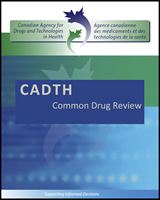Aim
The objective of this appendix is to provide a summary of the extension phase of study EINSTEIN DVT, named EINSTEIN Extension.5
Findings
EINSTEIN DVT was an open-label RCT enrolling patients with acute symptomatic deep vein thrombosis (DVT). Patients were randomized to oral rivaroxaban alone (15 mg twice daily for three weeks, followed by 20 mg once daily) or subcutaneous enoxaparin followed by a vitamin K antagonist (VKA) for three, six, or 12 months. The purpose of EINSTEIN Extension was to explore the benefit-to-risk ratio when treatment with rivaroxaban is administered after six to 12 months of anticoagulation. This was a double-blind, event-driven superiority study. Eligible patients were randomized using a computerized voice-response system with stratification by country. The intended treatment duration was determined by the treating physician. The primary outcome in this extension study was recurrent venous thromboembolism (VTE). Major bleeding was the key safety outcome, which was defined consistently with that in EINSTEIN DVT. Analyses of the treatment effects and bleeding were performed in pre-specified subgroups.
The trial characteristics are summarized in .
EINSTEIN Extension Study Characteristics.
summarizes the trial findings. EINSTEIN Extension included 1,197 patients: 34.1% of the patients had completed EINSTEIN DVT, 19.1% had completed EINSTEIN PE, and the remaining 47.5% were referred from outside both EINSTEIN DVT and PE. Six hundred and two patients were randomized to continuous rivaroxaban therapy, and 595 patients were randomized to placebo (one was excluded from intention-to-treat (ITT) analysis due to invalid informed consent).
EINSTEIN Extension Study Main Findings.
Patient characteristics between EINSTEIN DVT and EINSTEIN Extension were similar with respect to gender, weight, and creatinine clearance. In EINSTEIN Extension, the demographic and clinical characteristics of patients in the two groups were comparable; the mean age was 58 years, and the median time from onset of symptoms to randomization was 204 days in the rivaroxaban group and 206 days in the placebo group. The duration of treatment was shorter than intended for 156 patients (25.9%) in the rivaroxaban group and for 148 patients (24.9%) in the placebo group. Follow-up for the primary efficacy outcome was completed for 99.8% of the patients in both groups. More patients in the rivaroxaban group discontinued study because of adverse events (AEs) than those in the placebo group.
Continuous rivaroxaban therapy was associated with an 82% reduction in recurrent VTE compared with placebo (eight events in the rivaroxaban group and 42 events in the placebo group; hazard ratio 0.18; 95% CI, 0.09 to 0.39). The difference between the two groups was statistically significant. The majority of the VTE events were non-fatal pulmonary embolism (PE) and recurrent DVT.
Rivaroxaban-treated patients experienced more major bleeding (four in the rivaroxaban group and none in the placebo group), although the difference between the two groups was not statistically significant. More clinically relevant non-major bleeding events were reported in the rivaroxaban group as well. There were three deaths in EINSTEIN Extension, one (PE-related) in the rivaroxaban group, and two (one PE-related, one cancer-related) in the placebo group. No patient in either group had an elevated alanine aminotransferase level exceeding three times the upper limit of the normal range, or a bilirubin level exceeding twice the upper limit of the normal range.
EINSTEIN Extension was sponsored by the manufacturer, which collected and maintained the data, whereas all suspected outcome events were classified by a central independent adjudication committee, members of which were unaware of the treatment assignments. Power calculation for this superiority trial was provided and deemed appropriate. Data were analyzed in the ITT population. Loss to follow-up was low in both groups in this study.
Summary
In EINSTEIN Extension, patients’ baseline characteristics were comparable between rivaroxaban and placebo, and were also similar to the initial EINSTEIN DVT trial. The incidence of death was similar for rivaroxaban and placebo (one patient [0.2%] versus two [0.3%], respectively). Patients treated with continuous rivaroxaban reported significantly lower rates of recurrent VTE (1.3% with rivaroxaban versus 7.1% with placebo, hazard ratio = 0.18 [95% CI, 0.09 to 0.39], P < 0.001). Major bleeding was reported in four patients treated with rivaroxaban, but not in placebo-treated patients (0.7% versus 0, P = 0.11). Higher rates of clinically relevant non-major bleeding were observed in the rivaroxaban group compared with placebo (32 patients [5.4%] versus 7 [1.2%], respectively).
Compared with the results from EINSTEIN DVT, patients who received continuous rivaroxaban after six to 12 months of acute anticoagulation therapy had lower death rates, lower recurrent VTE, and fewer major bleeding events. For patients treated with rivaroxaban, the rate of withdrawal due to AEs was slightly higher in EINSTEIN Extension than in EINSTEIN DVT (6.5% versus 4.9%, respectively).
This placebo-controlled trial concluded that monotherapy with rivaroxaban provided an effective and safe approach to the continued treatment of venous thrombosis, without the need for laboratory monitoring. However, compared with another anticoagulant, there is a lack of evidence of long-term clinical efficacy and safety of rivaroxaban, particularly for patients with active cancer, for the treatment and prevention of recurrence of VTE.

